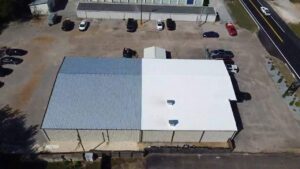
In the world of commercial roofing, steep slope roofs hold a special place. These roofs not only provide excellent protection against weather elements but also add a touch of elegance to the overall design. If you’re considering installing or repairing a steep slope roof for your commercial building, this article will guide you through the basics, materials used, benefits, installation process, and maintenance tips to ensure lasting performance.
Understanding Steep Slope Roofing
Steep slope roofing refers to roofs that have a pitch greater than 3:12. This means that for every 12 horizontal units, the roof rises by more than 3 units vertically. The steeper the slope, the more challenging the installation becomes. However, with the right materials and professional expertise, steep slope roofs can transform the appearance of any commercial building.
When it comes to steep slope roofing, one must consider not only the pitch of the roof but also the various components that make up the system. From the roof deck to the outer roofing material, each layer plays a crucial role in ensuring the durability and functionality of the roof. Proper installation of these components is essential to guarantee the long-term performance of the steep slope roof.
The Basics of Steep Slope Roofing
A steep slope roof consists of multiple layers that work together to provide effective water shedding and protection. The three main components include the roof deck, underlayment, and outer roofing material. The roof deck is the structural base that supports the weight of the roof and provides a solid foundation. The underlayment acts as a secondary barrier against water infiltration, while the outer roofing material serves as the aesthetic cover.
Moreover, steep slope roofs are known for their versatility in accommodating various roofing materials. Whether it’s asphalt shingles, metal panels, or clay tiles, steep slope roofs can be customized to suit the architectural style and design preferences of the building owner. This flexibility in material selection allows for creativity and uniqueness in the overall look of the roof.
Key Features of Steep Slope Roofs
Steep slope roofs offer several advantages over their flat or low-slope counterparts. Firstly, their pitch promotes efficient water runoff, preventing the accumulation of water, snow, or debris on the roof. This reduces the risk of leaks and water damage. Secondly, steep slope roofs provide better ventilation options, improving energy efficiency and prolonging the life of the roofing system. Lastly, they enhance the visual appeal of commercial buildings, creating an attractive and professional appearance.
Additionally, steep slope roofs are designed to withstand harsh weather conditions, making them a reliable choice for buildings located in areas prone to heavy rainfall or snow. The steep angle of the roof helps to shed water and snow quickly, preventing structural damage and maintaining the integrity of the building. This resilience to environmental factors is a key factor in the popularity of steep slope roofing systems in commercial construction.
Materials Used in Steep Slope Roofing
When it comes to materials for steep slope roofs, two popular options are asphalt shingles and metal roofing. Each has its own distinct advantages and considerations.
Asphalt Shingles for Steep Slope Roofs
Asphalt shingles are one of the most commonly used roofing materials for both residential and commercial applications. They offer durability, affordability, and a wide range of color options. Asphalt shingles are relatively easy to install and provide excellent protection against leaks and weather elements. However, they may require periodic maintenance and are not as long-lasting as other materials.
Metal Roofing for Steep Slopes
Metal roofing has gained popularity in recent years due to its exceptional durability and aesthetic appeal. It can withstand extreme weather conditions, provides excellent fire resistance, and requires minimal maintenance. Metal roofs are available in various styles and finishes, allowing for customization to match the building’s design. However, they tend to be more expensive upfront and require professional installation for optimal performance.
Benefits of Steep Slope Roofing for Commercial Buildings
Choosing steep slope roofing for your commercial building offers numerous advantages that contribute to its growing popularity among architects, builders, and property owners.
Weather Resistance and Durability
Steep slope roofs are designed to withstand harsh weather conditions, including heavy rain, snow, and high winds. Their steep pitch allows water and snow to easily slide off, reducing the risk of leaks and damage. Additionally, steep slope roofs are built to last, providing long-term protection and peace of mind for commercial property owners.
Aesthetic Appeal and Design Flexibility
With steep slope roofing, commercial buildings can achieve a unique and eye-catching look. The wide variety of materials, colors, and styles available allows for customization to match the building’s architectural style and overall design. Whether you prefer the classic elegance of asphalt shingles or the modern sleekness of metal roofing, steep slope roofs offer design flexibility to suit any aesthetic preference.
Installation Process of Steep Slope Roofing
Installing a steep slope roof requires careful planning, skilled labor, and adherence to industry standards. Here are some key considerations and steps involved in the installation process.
Pre-Installation Considerations
Prior to installation, it is crucial to assess the building’s structural integrity and choose appropriate materials based on local climate conditions. Proper ventilation and insulation must also be considered to prevent moisture buildup and energy inefficiency. Consulting with a professional roofing contractor is essential to ensure that all necessary measures are taken.
Steps in Installing Steep Slope Roofs
- Preparation: This involves removing the existing roof materials, inspecting and repairing the roof deck if necessary, and applying a suitable underlayment.
- Flashing and Water Barriers: Installing flashing at vulnerable areas and adding water barriers further enhance the roof’s waterproofing capabilities.
- Roofing Material Application: Depending on the chosen material, the roofing installer will lay each shingle or metal panel with precision and attention to detail.
- Finishing Touches: Ridge caps, hip caps, and other finishing components are installed to ensure a professional and seamless appearance.
- Clean-up and Final Inspection: The job isn’t complete until the work area is cleared of debris and a final inspection is conducted to ensure quality and compliance.
Maintenance and Repair of Steep Slope Roofs
Proper maintenance and prompt repairs are essential for the long-term performance of steep slope roofs. Regular inspections and proactive measures can prevent small issues from turning into costly problems. Here are some key maintenance tips and common roof issues to watch out for.
Regular Maintenance Tips
- Keep the roof clean and free from debris, such as leaves, branches, and moss.
- Inspect the roof regularly for signs of damage, such as cracked or missing shingles, loose flashing, or damaged gutters.
- Trim overhanging tree branches to prevent potential damage from falling limbs.
- Ensure proper ventilation to prevent condensation and mold growth.
Identifying and Addressing Common Roof Issues
Over time, steep slope roofs may encounter common problems such as leaks, worn-out shingles, or damaged flashing. Promptly addressing these issues can prevent further damage and extend the lifespan of the roof. It is recommended to hire a professional roofing contractor for repairs to ensure proper diagnosis and quality workmanship.
By understanding the basics, exploring material options, considering the benefits, and following proper installation and maintenance protocols, commercial property owners can reap the rewards of a durable and visually appealing steep slope roof. Consultation with a qualified roofing professional is key to making informed decisions and ensuring the longevity of your commercial roof.
Ready to ensure your commercial property is safeguarded with a top-tier steep slope roofing system? Look no further than Commercial Roofing Rana, your trusted partner in the Mid-South for all your commercial roofing needs. With our extensive experience serving a diverse range of commercial clients since 1983, we’re committed to delivering the highest quality roofing services. Our Duro-Last roofing systems are precision-engineered for a perfect fit, providing unmatched protection against the elements. Don’t let water damage threaten your business—let our licensed professionals at Commercial Roofing Rana fortify your building’s first line of defense. Whether you manage an industrial facility, healthcare center, church, or retail space, we have the expertise to handle your roofing project with excellence. Schedule Now! and let us help you protect your investment with a durable and aesthetically pleasing steep slope roof that stands the test of time.
